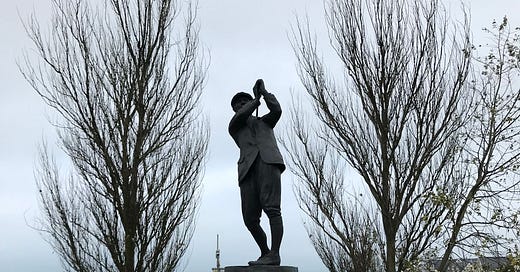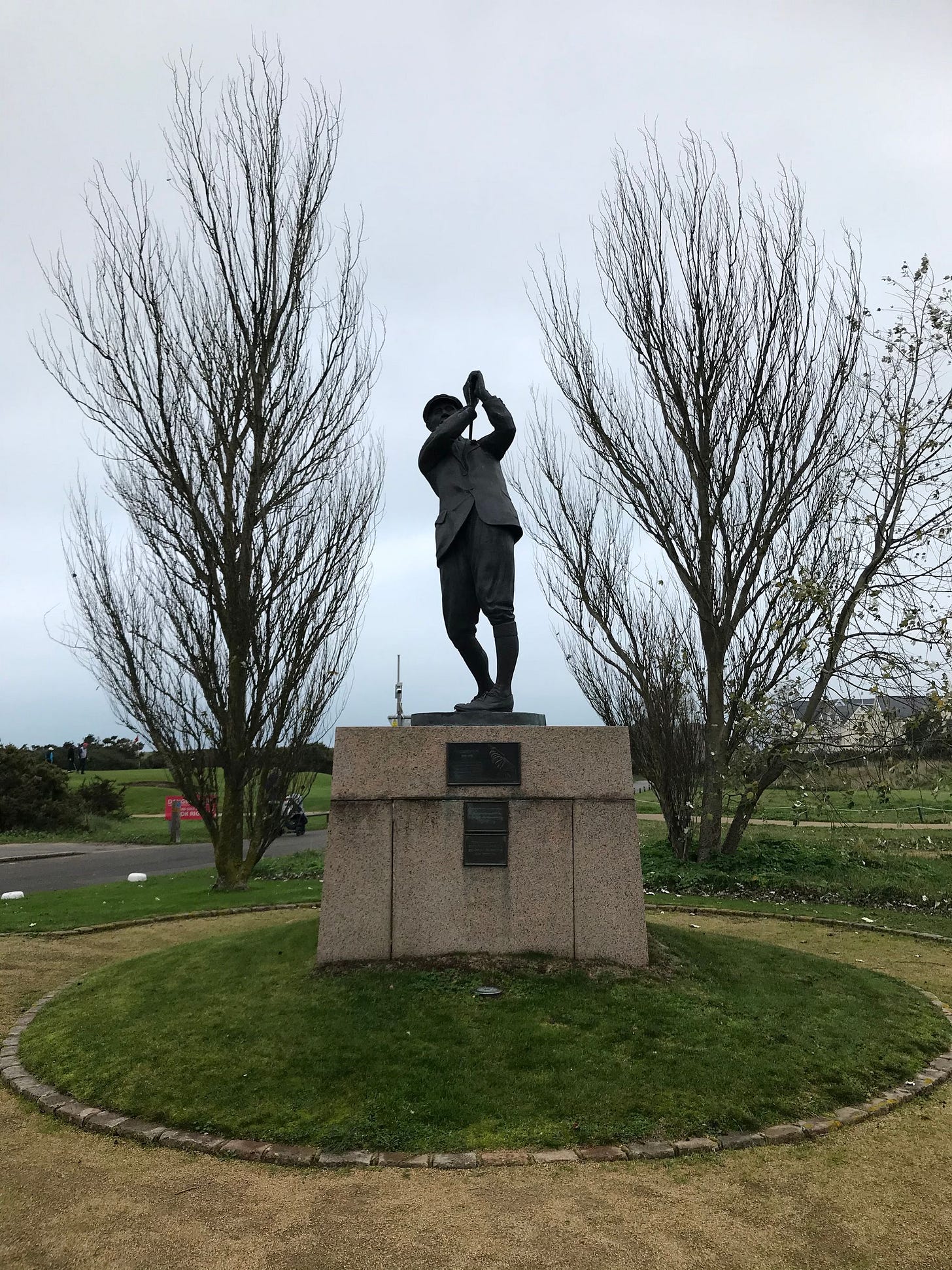Welcome to another episode of the History Islands. This week, we conclude our multi-part series on the life of Harry Vardon, one of the greatest golfers in history. We rejoin him in New York City in 1900, on the brink of global fame and a tour that would help establish the popularity of golf across America.
Harry Vardon
New York City, February 1900
After a hearty breakfast, I conquer Manhattan. Horses and traps are thronging the streets, manure is overflowing the gutters, even the occasional motor car is hooting and weaving its way through the crowd. The energy here is mesmerising.
I sit beneath the skyscrapers, sheer vertical walls of stone. There’s nothing like them in London, let alone in the squat streets of old St Helier. I sit awhile gazing up at them, smoking my pipe, observing how they slice the clouds like a clean shot. As I gawp, a couple of urchins, in that thick Yankee brogue, point at me and laugh. Then they break into a cheery song: “Oh to be back in dear old England, again!”. They hoot and wave at me, but in a kindly way. You see, my manners have betrayed me; pipe smoking, a habit as unremarkable to me as breathing, is the tell-tale sign, it seems, of a foreigner, and a Britisher to boot. I wave back at them, and suddenly I remember my own barefoot days, on the Grouville heath, watching the arrival of the strange men from another land.
Here in America everything is discarded, everything made new. When I leave my shoes outside the hotel room to be cleaned, they seem utterly perplexed at the request, and think I want them sent to the ‘trash can’. New York is a whirlwind. I see the brownstone tenements, the crush of people fighting for air, from the sleek financiers of Wall Street to the slum dwellers of Five Points. London feels cramped and old, but this city is still in the process of being born.
And this morning, New York City belongs to me. The newspapers are headlining my arrival; my name is in lights. The American press has taken my few mumbled words in the lobby yesterday and given them wings. The sports coverage is a flight of fancy, of exclusive revelations, banner headlines; the Open Champion arriving to claim a new world. They’ve printed all kinds of quotes I can scarcely remember saying, and most likely never did, but the spirit is plain to see. “Vardon arrives! Vardon to play in New Jersey! Vardon confident he will beat the record”. This pipe-smoking curiosity has become the talk of the town.
Charlie, my agent, has arrived, and our cab is waiting. There is a smaller gaggle of reporters this morning; the rest must have already moved onto the next story, the next novelty. This coming week I will tour the city like a prince, take in a brace of Broadway shows and enjoy these strange new climes. The sun is blazing high over the city, a fresh winter’s morning, with the promise of Spring to follow. Half a world away, I think of Jessie, knitting by the fireside in the gathering Jersey darkness, lost in the maze she has built for herself.
I have chosen a different path. The wide road ahead will take me thousands of miles, from Madison Avenue to the orange groves of Florida. My gargantuan lump sum fee for the tour has already been safely deposited in the bank. Five dollars to the pound, as every schoolboy knows; but I need hardly care, for every expense, every luxury hotel and first-class train fare has been provided for me. All I have to do is one thing – as the poet Newbolt says, “play up, and play the game!”
The elevator opens. The gates part before me. The staircase gleams ahead of me, betraying no memory of the tragedy that Charlie tells me once happened here. I lock my smile in place. Then I stroll down the steps, across the marble lobby, brushing past the liveried doormen, and stride out through the magnificent door.
Harry Vardon went on to win the US Open of 1900. In his glittering career, he became known as the “King of Clubs”. He singlehandedly revolutionised the game of golf; his innovative Vardon grip becoming the global standard. When he discarded the cumbersome golfing apparel of yore and took the radical step of sporting knickerbockers, the golfing world spun on a dime and embraced the new fashion. Vardon’s signature style - a white shirt with braces and generous one-inch collar, knickerbockers and knee-length socks, became the sartorial standard.
Vardon shocked the gentlemen dilettantes of the day. He played golf relentlessly, hour after hour, hole after hole, until the blackness of the night finally stopped him. In his obsessive practice regime, his consummate discipline, as much as his style, Vardon was the shape of things to come.
Vardon’s hypnotic sparring match with Francis Ouimet in 1913 proved the touch-paper that lit America and turned the nation into a golfing powerhouse for the century to come. Though he lost that celebrated clash, even life-threatening illness could not stop the boy from Grouville. Vardon won his fourth British Open victory while in the incipient throes of tuberculosis, and after a painstaking recovery, he would roar back to claim two more Open titles.
His final triumph came in 1914, in the summer when the world fell into the abyss, a sublime coda to a mesmerising career. “The Sovereign Lord and King of the golfing world”, the press had once dubbed him, and long he would reign in strength and power.
And yet his life proved a double tragedy. Estranged from his grief-stricken wife, in late middle age, he fathered a lovechild with a Midlands showgirl called Tilly. They had a little baby boy. For a few short months, he was blissfully happy.
For a handful of precious years, Vardon played the role of the mysterious millionaire ‘uncle’, turning up with presents for his beloved boy, until the situation became too awkward, and he was barred from any further contact. Vardon continued to pay the school fees from afar, for the son he would never know.
Heading in now, as the sun set over the sands, he found solace in writing his autobiography. Yet with his lungs ravaged by decades of pipe-smoking and the scars of tuberculosis, Vardon would not make old bones. He died in 1937, laden with honours and wealth, but with a heart forever frozen.
Set amidst the dunes of Grouville, the Royal Jersey Golf Club remains the Island’s pre-eminent golfing establishment. It boasts ties to some of the most illustrious players from the annals of the game.
The cottage where Vardon was born is long since gone. When old Eliza Vardon eventually died, the workmen finally claimed their prize. The little home was demolished, swallowed up by the twelfth fairway. No stone remains.
Today, at the grand entrance to the Royal Jersey Golf Club, a bronze statue stands. It is forged in the unmistakeable likeness of a Jerseyman in a flat cap and knickerbockers, driving a ball with uncanny precision, deep into the grey clouds rolling in from the bay. It reminds us that a giant once passed through these lands.
This is the poor boy from the dunes, who smashed his way into history to claim six British Open victories. More than a century has slipped by since those far-off sepia days, years of Occupation and prosperity, and a great game that has changed beyond all imagining.
One thing remains. Vardon’s record stands unbroken.
Paul Darroch's books are available from Amazon UK, the Harbour Gallery, Waterstones and WH Smith in Jersey.
(c) Paul Darroch 2023




